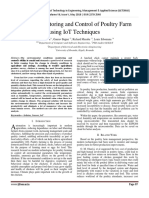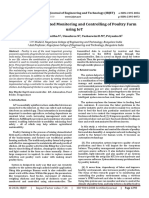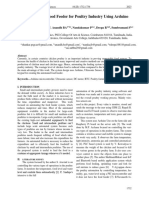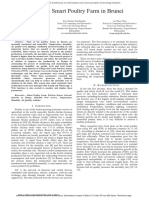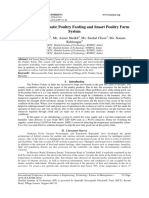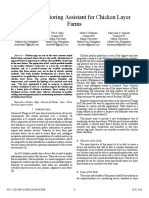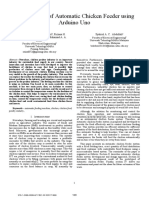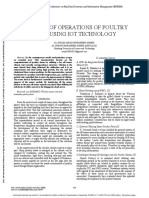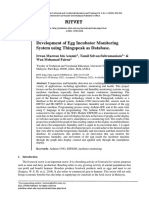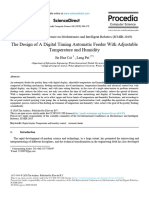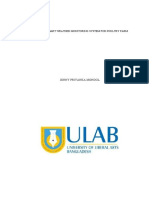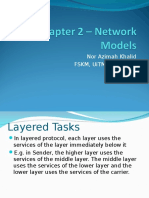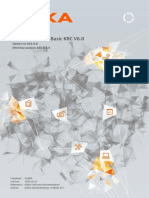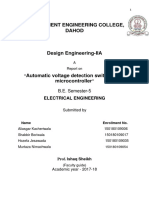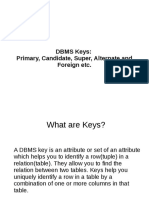Evolution in Electrical and Electronic Engineering Vol. 1 No.
1 (2020) 317 - 325
© Universiti Tun Hussein Onn Malaysia Publisher’s Office
EEEE
Homepage: http://publisher.uthm.edu.my/proceeding/index.php/eeee
e-ISSN : 2756-8458
Smart Chicken Farm Monitoring System
Mohamad Lokman Ali1, Munirah Ab. Rahman1*,
Nik Shahidah Afifi Md Taujuddin1
1
Faculty of Electrical and Electronic Engineering,
Universiti Tun Hussein Onn Malaysia, Parit Raja, 86400, Johor, MALAYSIA
DOI: https://doi.org/10.30880/eeee.2020.01.01.038
Received 14 August 2020; Accepted 06 September 2020; Available online 30 October 2020
Abstract: Recently, the using of smart technology are common working process in
various field such as agriculture, traffic light and medical. In the process of poultry
farming in the world, rapid development of technology has been built such as closed
poultry farming equipped with technological systems and more to smart farming
system due to the high demand for chicken broiler all over the world including
Malaysia. As a consequence, many new poultry farmers have ventured into this field.
However, many of them suffer from problems such as chicken diseases due to the
unconducive environment of chicken coop. Unsuitable temperature and humidity in
chicken coop may lead the chicken susceptible to disease such as Coryza which
causes chicken eyes become swollen and loss appetite. Therefore, a system named
Smart Chicken Farm Monitoring System has been developed to monitor and control
the environment of chicken coop by using sensors and Internet of Thing (IoT)
platform. With this system, poultry farmers can monitor and control the temperature
and humidity in the coop using DHT11 automatically. Poultry farmers can also
estimate the weight of chickens by using the load cell sensor to identify the maturity
of chicken broilers in the coop. This system is believed may help chicken farmers in
monitoring a conducive chicken coop and the growth of the chicken broiler.
Keywords: Chicken Farm, Internet Of Things, Monitoring System
1. Introduction
From the perspective of the world, approximately 30 federally-inspected companies are involved
in the business of raising, processing and marketing chickens on a “vertically integrated” basis – that
is, the company is able to ensure quality at each step of the process. In United Stated, about 25,000
family farmers have production contracts with the companies. Approximately 95 percent of broiler
chickens are produced on these farms, with the remaining 5 percent raised on company-owned farms
or farms without contracts. The populations of the global in 2019 reach 7.7 billion so the increasing
demand for animal protein is a real challenge even for broiler industry [1].
In Malaysia, at the peninsular of Malaysia about 771,674,578 million of chicken broiler produced
in year 2018. The total domestic poultry production amounted to 1,295, 000 metric tons worth RM
5.776 billion. Local consumption of poultry is 1,103,000 metric tons a year. Chicken meat is a type of
white meat that many Malaysians use daily. Johor is the leading bird breeder in Malaysia with a total
of 60.097 million chickens raised in 2018. Currently, Malaysia is exporting live birds and processed
*Corresponding author: munira@uthm.edu.my
2020 UTHM Publisher. All rights reserved.
publisher.uthm.edu.my/proceeding/index.php/eeee
�Mohamad Lokman Ali et al., Evolution in Electrical and Electronic Engineering Vol. 1 No. 1 (2020) p. 317-325
poultry products to Singapore and some Middle East countries. Singapore is the largest poultry market
where over 1.716 million live birds were exported every day in 2018. Malaysia is taking an advantage
of its geographical proximity to penetrate Singapore's market.
The system of chicken farming has two categories which are traditional chicken farming and also
commercial. Traditional chicken farming is ran by many villagers who traditionally raise chickens.
Almost of traditional chicken farming use the free-range environment [2]. For commercial chickens
farming, they use poultry (black, brown or dark brown) that is produced through breeding. Their uses
closed housing system and adopt modern technologies. The modern technology used is included feeding
system, disinfection method, vaccination practices, and odor pollution control. The chicken broilers are
sensitive against the temperature and humidity. Its need the conducive environment that is suitable for
the growth of the chicken broilers. There are suitable average age for the chicken broiler and the suitable
temperature and humidity against chicken broilers ages [3].
The purpose of Chicken Farm Monitoring System is able to monitor the temperature, humidity and
average weight of chicken broilers in coop automatically. These processes are using the Internet of
Thing platform. The systems operate automatically by using specific sensor and equipped with internet
module. The weighting sensor is used to measure the average of the total chicken broiler in the coop.
This can help farmer to monitor the activities in the chicken coop daily.
1.1 Problem statement
Chicken broilers are sensitive against the environment. The chicken broilers need conducive
environment with suitable temperature and humidity. Unsuitable temperature and humidity may lead
the broiler to get chicken diseases. For example of diseases especially Coryza, this disease can causes
the chicken eyes swollen and loss of appetite to eat [4]. The poultry industries in Malaysia are usually
using the manually working process in controlling temperature and humidity in the chicken coop. This
situation is uneffective in which the chicken farmer has to check the temperature and humidity regularly
hence utilize a lot of time and energy.
Next, poultry industry in Malaysia also facing a problem of monitoring the weight and maturity of
the chicken broiler. Farmer need to weight chicken broilers one by one using the equipment of dacing
weighting scale [5]. This process need to be repeated once a week by the farmer. This work was
unpractically due to the long term process.
1.2 Objective
To develop a circuit that is able to measure the temperature and humidity of chicken coop also
the average weight of chicken in the coop.
To monitor the measured parameter of temperature, humidity and average chicken weight by
using IoT platform
To control the parameter of the temperature and humidity automatically.
2. Materials and Methods
This project uses a few devices and components as explained in sub section 2.1. While for project
development, it consists of four phases as described in sub section 2.2. The steps and procedures must
be planned carefully and systematically to achieve the stated objectives.
2.1 System design and materials
Figure 1 shows the block diagram of the project system design. There are two sensors that been
used in this project which is DHT11 (humidity sensor) and load cell sensor. The DHT11 serves as a
tool to detect temperature and humidity in the chicken coop. While the load cell sensor detects the entire
weight of the chicken broilers in the coop. This project design requires a microcontroller to act as a
318
� Mohamad Lokman Ali et al., Evolution in Electrical and Electronic Engineering Vol. 1 No. 1 (2020) p. 317-325
controller for the project. Arduino WeMo’s D1 hardware has been used as it comes with a Wi-Fi
module. DHT11 acts as input control the bulb and cooling fan which are acting as output in this project.
For IoT platform, cloud system Blynk has been used. The input data of weight, temperature and
humidity have been sending and save at the cloud system with help of Wi-Fi module. The data stored
at the Blynk cloud can be accessed by other devices. The devices function is to monitor all the activities
in the coop.
Figure 1: Block diagram of project system design
2.2 Methods
In order to develop the project, it has to follow a few phases. Figure 2 shows the flow of project
using the flow chart diagram. There are four phases include research of project, software development,
hardware development and software and hardware integration.
2.2.1 Phase 1: Research of project
The phase 1 explains about the process of research project. In Malaysia, the demanding of the
chicken broiler has highly demand. The project purpose is to help the chicken farmer in Malaysia by
using IoT platform. It is to improve the traditional system into the automatically system aiming in
producing high quality of chicken broiler. This new era’s, the technology of IoT is widely used,
operating in cloud system. The cloud system is providing space to save all data safely. Figure 3 shows
the IoT platform of Blynk interface for this project.
2.2.2 Phase 2: Hardware development
Figure 4 shows the hardware design of project prototype. In this project the hardware that been used
is Arduino WeMo’s D1, DHT11 (humidity sensor), weighting sensor, bulb and cooling fan. The process
is to monitor and control the activities in the coop such as to monitor the temperature and humidity in
the coop. Then, if the temperature and humidity change, it will control the movement of the bulb and
the cooling fan. This is to prepare a conducive environment in the coop to avoid the chicken disease.
The sensor of weight has been put inside the coop. It can function properly under the coop to calculate
the total weight of the chicken broiler then give the mean result for the chicken broiler weight. The
temperature and humidity sensor has been places at the middle of the coop. The cooling fan and bulb
are placed at the top of roof in the coop. It can easily operates over there and not disturb the chicken
broiler spaces.
319
�Mohamad Lokman Ali et al., Evolution in Electrical and Electronic Engineering Vol. 1 No. 1 (2020) p. 317-325
Figure 2: Flow of project implementation
Figure 3: Blynk interface as IoT platform
2.2.3 Phase 3: Software development
In the phase 3, the software development is about to create the coding and the system. In this project,
the software that been used is Arduino software. The Arduino WeMo’s D1 microcontroller needs to be
coded using the C++ programming language. It is to control the movement of the devices and system.
Figure 5 shows the flow of the system using the flow chart diagram. For this project, the hardware used
are microcontroller Arduino WeMo’s D1, humidity sensor (DHT11), load cell sensor, bulb and cooling
fan. The initialization part in the flow chart represent as the Arduino WeMo’s D1 microcontroller. The
microcontroller acts as the main resources to conduct the working process.
The weighting chicken broiler part, includes the weighing sensor which is using load cell sensor.
This sensor is used to measure the total weight of the chicken broiler in the coop. The process of
measuring total weight of chicken broiler continued as long as the system is running. Next, for the
320
� Mohamad Lokman Ali et al., Evolution in Electrical and Electronic Engineering Vol. 1 No. 1 (2020) p. 317-325
monitoring of temperature and humidity part includes the sensor of the DHT11. This sensor measures
the temperature and humidity in the coop. The DHT11 outputs are at the bulb and cooling fan. Figure 5
shows if the temperature is less than 30˚C the bulb will be lighted up. This is to maintain the temperature
in the coop. If the temperature goeshigher than 30˚C, the fan will be turned ON and the bulb is turned
OFF to cooldown the environment in the coop. The fan will turn off when the temperature reaches 30˚C
again.
For the humidity process, the DHT11 measures the humidity in the coop by using the percentage of
the air. If the humidity in the coop below 60% it will on the cooling fan. If the humidity in the coop
exceed 70% the bulb will be lighted up until the humidity reach the range of 60%-70%.
Figure 4: Hardware design of project prototype
Figure 5: Flow of the system
2.2.4 Phase 4: Hardware and software integration
Phase 4 explained about the integration of the software and hardware. The combining of software
and hardware can be seen based on the testing process. Mostly a project takes a lot of time at the testing
part. The troubleshooting for the project was a tricky part. The problem that always be faced for the
hardware part is the connection of the cables and the unworkable device sensors. For the software part
is the coding has an error while it was compiled. This process gives the challenging experiences in
solving the problem. If the testing part is successfully, the project can run automatically and the data
cloud will operate properly.
321
�Mohamad Lokman Ali et al., Evolution in Electrical and Electronic Engineering Vol. 1 No. 1 (2020) p. 317-325
3. Results and Discussion
This section presents the results from the project as well as the analysis of the data obtained. The
results and discussion reflected the objectives that aforementioned in section 1.
3.1 Temperature and humidity measurement
Figure 6 shows the measurement of temperature and humidity using thermometer and DHT11 in
the Blynk interface. While Table 1 shows the measurement readings of temperature and humidity taken
for every 5 minutes. Thermometer serves as the actual reading reference for temperature and humidity
in the coop. Based on the readings, it shows that the DHT11 sensor used in this project has high accuracy
in taking measurement as its reading near to the thermometer reading.
Figure 6: Measurement of temperature and humidity using thermometer and DHT11
Table 1: Result of thermometer and DHT11 readings
Thermometer DHT11
Minutes Temperature(˚C) Humidity (%) Temperature(˚C) Humidity (%)
5 28 70 29.6 73
10 28 71 29.6 73
15 28 71 29.6 72
20 28 71 29.6 72
25 28 71 29.6 72
30 28 70 29.6 72
3.2 Weight measurement
Figure 7 shows the weight measurement for a group of coin using weight scale and load cell sensor.
While Table 2 shows the measurement readings of different weight of coins. The purpose is to make
the comparison between the weighting scale and the load cell sensor to show the functionally of the
load cell sensor. Based on th readings, it shows that the load cell sensor used in this project has high
accuracy in taking measurement as its reading near to the weight scale reading. Both weight scale and
load cell sensor had gone through calibration process before weight measurement. The calibration done
because to avoid the parallax error. Calibration for weight scale is done by ensuring zero reading at the
scale when there is no load load while calibration for the load cell sensor is done by pressing the button
reset at the Microcontroller Arduino WeMo’s D1 to reset the reading to become zero before weighing.
322
� Mohamad Lokman Ali et al., Evolution in Electrical and Electronic Engineering Vol. 1 No. 1 (2020) p. 317-325
Figure 7: Weight measurement for 100g coins using weight scale (left) load cell sensor (right)
Table 2: Result of weight scale and load cell sensor readings
Coins weight (g) Weight scale (g) Load cell sensor (g)
100 100 101
200 200 201
300 300 302
400 400 402
500 500 501
3.3 Controlling parameters for temperature and humidity
Referring to Figure 8, it shows the reading during the heating process of the chicken coop using
filament bulb. In this project, temperature and humidity have been set at 33˚C while for humidity is
between 60% -70%. Figure 9 shows the process of maintaining the temperature and humidity set in the
chicken coop. If the temperature exceeds the threshold temperature, the bulb has been turned OFF and
the cooling fan has been function for the purpose of cooling the temperature in the chicken coop. If the
temperature in the coop is controlled and less than 33˚C, the bulb will light up again and the cooling
fan will turn OFF.
Figure 8: Bulb ON for heating coop
323
�Mohamad Lokman Ali et al., Evolution in Electrical and Electronic Engineering Vol. 1 No. 1 (2020) p. 317-325
Figure 9: Cooling fan ON to cooldown the coop
4. Conclusion
There are three objectives that need to be achieved as a solution to the problems faced by poultry
farmers. All objectives in this project have been successfully achieved. For the first objective, a circuit
has been developed that is capable to measure the temperature and humidity of chicken coop also the
average weight of chicken in the coop. All sensors used have worked well in measuring the temperature,
humidity and average weight of chicken broiler. This is because with the formation of a good design
circuit, it has produced an orderly and functional system. For the second objective, this project has been
able to create a system that can monitor the measured parameters of temperature, humidity and average
chicken weight by using IoT platform. The platform that has been used in this project is the Blynk cloud
system. With the use of this platform, the poultry farmers can monitor all readings through devices such
as Smartphones or Personal computers no matter where he or she is. As this objective has been achieved,
the problem of poultry farmers to monitor temperature, humidity and average weight chicken remotely
has been overcome with this platform.
Lastly, a system has been developed that can control temperature and humidity parameters
automatically. Previously problems related to this objective, poultry farmers need the use of a large
number of workers to control all processes involved such as monitoring temperature and humidity at all
times to maintain temperature and humidity in a controlled state. With the achievement of this objective,
poultry farmers can reduce the use of workers because all processes have been able to be controlled
automatically.
Acknowledgement
The authors would also like to thank the Faculty of Electrical and Electronic Engineering, Universiti
Tun Hussein Onn Malaysia for the financial support of this project.
References
[1] M.I.Sakhatskiy, “Broiler meat production in the world,” Poult. Farming Equip., 2018
[2] A. Abdelqader, C. B. A. Wollny, and M. Gauly, “Characterization of local chicken production
systems and their potential under different levels of management practice in Jordan,” Trop.
Anim. Health Prod., vol. 39, no. 3, pp. 155–164, 2007
[3] N. N. Suryaman, U. Komaruddin, A. Hutomo, and Martoni, “Numerical study of distribution
temperature and air flow velocity at closed type chicken coop for capacity of 15,500 chicks
with opening 1 inlet and 4 exhaust,” Univers. J. Mech. Eng., vol. 7, no. 3, pp. 12–19, 2019
[4] Iyasu Angani Dereja, “Infectious Coryza in Jimma Backyard Chicken Farms: Clinical and
Bacteriological Investigation,” Anim. Prod., 2017
324
� Mohamad Lokman Ali et al., Evolution in Electrical and Electronic Engineering Vol. 1 No. 1 (2020) p. 317-325
[5] C. C. Lee, A. H. Adom, M. A. Markom, and E. S. M. M. Tan, “Automated Chicken Weighing
System Using Wireless Sensor Network for Poultry Farmers,” IOP Conf. Ser. Mater. Sci. Eng.,
vol. 557, no. 1, 2019
[6] 187 N Windy Mansion Rd, “Four Main Disease Types,” Free. Ranger Hatch., 2020
[7] N. S. Amir, A. M. F. M. Abas, N. A. Azmi, Z. Z. Abidin, and A. A. Shafie, “Chicken Farm
Monitoring System,” Proc. - 6th Int. Conf. Comput. Commun. Eng. Innov. Technol. to Serve
Humanit. ICCCE 2016, pp. 132–137, 2016
[8] S. Jindarat and P. Wuttidittachotti, “Smart farm monitoring using Raspberry Pi and Arduino,”
I4CT 2015 - 2015 2nd Int. Conf. Comput. Commun. Control Technol. Art Proceeding, no. I4ct,
pp. 284–288, 2015
[9] Z. H. C. Soh, M. H. Ismail, F. H. Otthaman, M. K. Safie, M. A. A. Zukri, and S. A. C. Abdullah,
“Development of automatic chicken feeder using Arduino Uno,” 2017 Int. Conf. Electr.
Electron. Syst. Eng. ICEESE 2017, vol. 2018- Janua, pp. 120–124, 2018
[10] Eri Prasetyo Wibowo, “Prototype of Feeding Devices, Temperatures and Humidity Monitoring
at Broiler Chicken Breeders With The Internet Of Things Concept,” Article, vol. 1, no. 4, p. 53,
2017
[11] D. Wicaksono, D. Perdana, and R. Mayasari, “Design and analysis automatic temperature
control in the broiler poultry farm based on wireless sensor network,” Proc. - 2017 2nd Int.
Conf. Inf. Technol. Inf. Syst. Electr. Eng. ICITISEE 2017, vol. 2018-Janua, pp. 450–455, 2018
[12] K. A. Sitaram, K. R. Ankush, K. N. Anant, and B. R. Raghunath, “IoT based Smart
Management of Poultry Farm and Electricity Generation,” 2018 IEEE Int. Conf. Comput. Intell.
Comput. Res. ICCIC 2018, pp. 1–4, 2018
325


